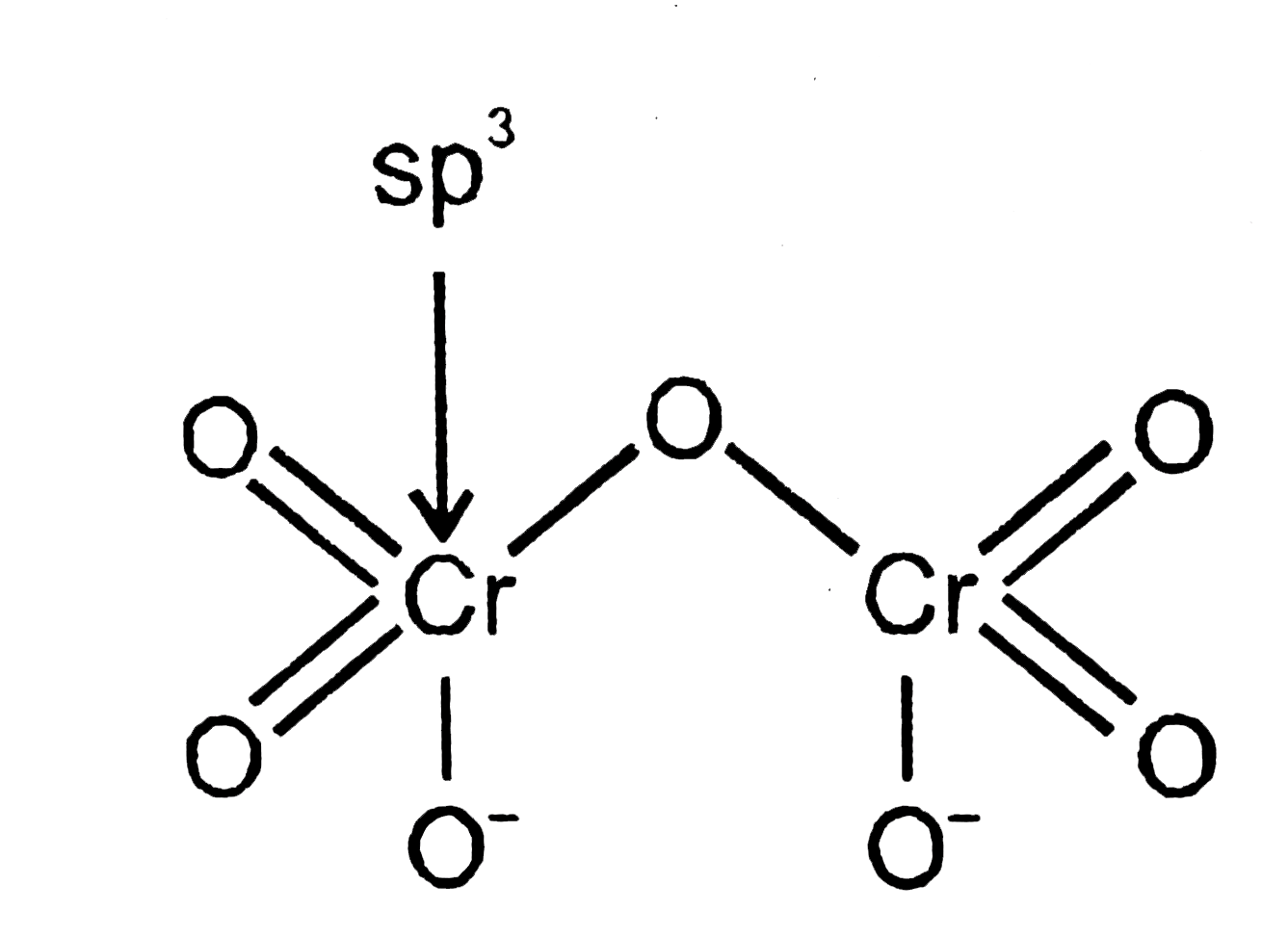An orange solid (A) on heating gave a green residue (B), colourless gas (C) and water vapour. The dry gas (C) on passing over heated magnesium gave a white solid (D).(D) on reaction with water have a gas (E) which formed dense white fumes with HCl. Indentify (A) to (E) and give the reactions.
The central atom(s) of the anion of solid (A) has sp3 hybridisation.
The orange sloid (A) is diamagnetic in nature.
The anoin of orange solid (A) is oxidising in nature.
None
The correct Answer is:D
A=(NH4)2Cr2O7
 , all electrons are paired. So diamagnetic (3d04s0)
, all electrons are paired. So diamagnetic (3d04s0)
Cr2O2−7 acts as strong oxidising agent in acidic medium.
Topper's Solved these Questions
- P BLOCK ELEMENTSBOOK - RESONANCE ENGLISHCHAPTER - P BLOCK ELEMENTSEXERCISE - ALP PART 1 Comprehension # 3 OBJECTIVE
1 Videos
- P BLOCK ELEMENTSBOOK - RESONANCE ENGLISHCHAPTER - P BLOCK ELEMENTSEXERCISE - ALP PART II SUBJECTIVE
1 Videos
- P BLOCK ELEMENTSBOOK - RESONANCE ENGLISHCHAPTER - P BLOCK ELEMENTSEXERCISE - ALP PART 1 Comprehension # 1 OBJECTIVE
8 Videos
- NUCLEAR CHEMISTRYBOOK - RESONANCE ENGLISHCHAPTER - NUCLEAR CHEMISTRYEXERCISE - STAGE-II
1 Videos
- P-BLOCK ELEMENT (BORON AND CARBON FAMILY)BOOK - RESONANCE ENGLISHCHAPTER - P-BLOCK ELEMENT (BORON AND CARBON FAMILY)EXERCISE - PART - III : OLYMPIAD PROBLEMS (PREVIOUS YEARS) STAGE - V (INTERNATIONAL CHEMISTRY OLYMPIAD (IChO)) Problem 3
8 Videos
Similar Questions
An orange solid (X) on heating, gives a colourless gas (Y) and a only green residue (Z). Gas (Y) on treatment with Mg, produces a white solid substance……
View SolutionFrom the substances - Ammonium sulphate , Lead carbonate ,Chlorine ,Copper nitrate ,Iron [II] sulphate - A compound which on heating with NaOH produces a gas which forms dense white fumes with HCl.
View Solution
Knowledge Check
A white solid X reacts with dil. HCl to give colourless gas which is used in fire extinguishers. The solid X is
ANaClBCH3COONaCNa2CO3DNaHCO3
Zinc on reaction with NaOH gives a salt (A) along with a gas (B).
(A) on reaction with H2S gas gives a white precipitate (C ).
Identify (A), (B) and (C ).
View SolutionWhen a white powder (A) is strongly heated, it gives of a colourless, odourless gas (B) which turns lime water milky (C) and if the passage of this gas is continued the milkiness disappears and gives a solution (D). The solid residue (E) is yellow when hot, but turns white on cooling. Idnetify (A) to (E) with help of the equations.
View SolutionA black mineral (A) on heating in presence of air gives a gas (B). The mineral (A) on reaction with dilute H2SO4 gives a gas (C) and a solution of a compound (D) on passing the gas (C) into an aqueous solution of (B), a white turbidity is obtained. The aqueous solution of (D) on reaction with potassium ferricyanide gives a blue compound (E). Identify (A) to (E) and give chemical equations for the reaction involved.
View SolutionAn element A reacts with water to form a compound B which is used in white washing. The compound B on heating forms an oxide C which on treatment with water gives back B. Identify A, B and C and give the reactions involved.
View SolutionCaCO3 on heating gives a white solid (A) and a gas (B), (A) on heating with carbon gives a solid (C) and a gas (D), (C) on hydrolysis glves a gas (E) and a solid (F) Identify (A), (B), (C), (D) , (E) and (F) .
View SolutionOixalic acid on stragheating gives (A) and (B) which are gaseous prouct and ( C) which is a liwue . Gas (B) turns lime water miky. Gas (A) on reaction with chlorine gas gives (D) . (D)m as wll as (B) on heating with ammonia gas gives the same produce ( E) . Identify (A) ,(B), ( C), (D) and ( E).
View SolutionOn treatment with cold water, an element (A) reacted quietly liberating a colourless, odourless gas (B) and a basic solution (C). Lithium reacted with (B) yielding a solid product (D) which effervesced with water to give a stongly basic solution (E) and gas (F). When CO2 was bubbled through solution (C), initially a white ppt. (G) was formed, but this redissolved forming solution (H) when more CO2 was passed, precipitate (G) effervesced when moistened with conc HCl and gave a brick red colouration to the bunsen flame. When (G) was heated with carbon at 1000∘C, a caustic white compound (I) was formed, which when heated with N20 at 1000∘C gave a solid (J) of some commercial importance. Identify (A) to (J) and explain the reactions.
View Solution
